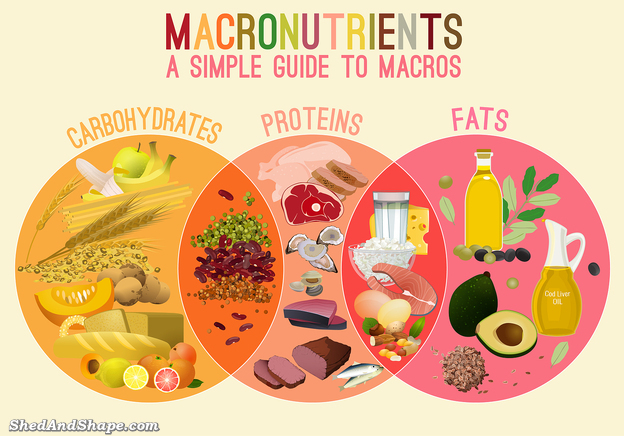What is a macro diet is a question that I have not addressed before on this blog so it’s about time I did. People often calculate macros when following a keto diet but the macro diet is not the same as a keto diet.
Unlike most weight loss diets that will deprive your body of food, the macro diet works differently. It can be useful if you want to lose weight in a healthy and safe way.
Most diets tell you to avoid certain foods to achieve weight loss. And while these diets may be effective in the short term, they often do not lead to sustainable weight loss because they will make you feel deprived.
But, with the macro diet you are encouraged to count nutrients and make smart food choices. It can get a bit complicated, especially if you don’t know exactly how it works. So, in this article I will explain exactly what a macro diet is and if it can help with weight loss.
What Is A Macro Diet?
Macros is short for macronutrients in foods. They are protein, carbohydrates, and fats, the main categories of nutrients which provide you with most of your energy. Each macronutrient plays an important role by providing the body with key nutrients:
Micronutrients are the vitamins and minerals that our bodies need in much smaller amounts in order to function.
Protein
Protein provides you with amino acids which are involved in growth, repair, building muscle, manufacture of enzymes and hormones, and good immune function. It can also reduce hunger and cravings.
Protein foods are meat, fish, poultry, eggs, dairy products, legumes, nuts and seeds.
Carbohydrate
Carbohydrates, often referred to as carbs, provide you with energy. When you eat these foods the starches get converted to glucose during the process of digestion. The glucose gets into your bloodstream where it gets used for energy.
What is not used for energy is stored as glycogen which can get turned back to glucose to provide energy if needed. But, when glycogen stores are full the remainder is stored as fat. People cut down on carbs to lose weight.
Related reading: How Many Carbs Do You Need To Eat To Lose Weight?
Fat
For years we have been led to believe that fat is bad for us but in fact it is needed by every cell of your body for health.
Your cell membranes are made up of phospholipids (fat), triglycerides and cholesterol. Your brain is about 60% fat!
Various types of fat is needed by your body for many functions. Fat in your diet helps with absorb the fat-soluble vitamins A, D, E and K. It’s needed to produce hormones.
Related reading: Best Fats To Eat On A Low Carb Diet
Fat protects your organs and provides insulation during cold weather. It is a source of energy as many people who follow the keto diet discover when they reduce carbs and switch to fat burning through ketosis.
There are bad fats as well as good fats so with any healthy diet you must avoid the bad fats like trans and hydrogenated fats and eat the good fats in the right ratios.
Related reading: Keto Diet Fats : Best and Worst To Eat
When following the macro diet, you must consider the individual number of protein, carbs, and fats in every food and modify this based on your weight loss goals.
No calorie counting
So, instead of keeping track of calories which takes no account of nutrients and is what most diets ask you to do, the macro diet helps you track the components of the calories that fuel your body.
The macro diet emphasizes the value of whole foods, rather than processed foods. So, it’s not like the calorie controlled diets where you can eat anything you like so long as you stick to your calorie limit.
Related reading: Do You Need to Count Calories on a Keto Diet?
However, this diet is not something that you can easily manage on your own. You will do better if you use an online calculator such as this free online macros calculator or an app like My Macros+ or IIFYM.
Related reading: How To Calculate Macros For Weight Loss
Some people prefer to find a nutritionist who will take into account body type, goals, lifestyle plus any medical conditions before determining your macro ratios.
Ariane Hundt, a nutritionist based in New York states:
Everyone’s different, but when macros are customized, one can lose between 2% and 5% body fat in a month and an average of 10 pounds in the first month.
What Are the Benefits of the Macro Diet?
There are a number of good benefits that result from following the macro diet.
1. Weight Loss
Tracking your macros and keeping them at the best level you would also eliminate excess calories from your diet. Eventually, you will begin to experience weight loss.
2. Muscle Gain
A lot of people struggle to eat the amount of protein needed to build and repair muscles after a workout. If you start to count macros by following a macro diet, you can make sure that you are getting enough protein to help you gain muscles.
3. Make Smart Food Choices
To achieve weight loss, people need a structure to guide them with their eating habits. Otherwise, you will end up eating anything you crave, which could result in weight gain. With the macro diet, you will be able to pay more attention to the food that you eat and make smart choices. This will have a good impact on your health and will result in weight loss.
4. Optimal Body Function
By eating an ideal amount of protein, carbs, and fat, your body will be able to function optimally. Carbohydrates fuel your body for energy production while proteins help to build up your muscle mass, immune system, and metabolism. Meanwhile, fats are responsible for absorbing essential nutrients in the body.
How Can You Lose Weight on the Macro Diet?
The key to achieving weight loss on a macro diet is to calculate macros according to your size, age, and level of activity.
Generally, these are the recommended macro ratios to achieve weight loss:
• If you exercise daily for an hour or less, the recommended macro is 30% protein, 30% fats, and 40% carbs.
• For those who exercise 1 to 2 hours daily, the recommended macro ratio is 30% protein, 25% fat, and 45% carbs.
On a keto or low carb diet the fat percentage is usually higher and the carb percentage may be lower for quick weight loss.
If you exercise more than two hours a day you might consider seeing a certified dietitian or nutritionist. They can personalize a macro ratio to help you lose weight safely.
How to Count Macros?
It’s not enough that you know what is a macro diet. You should also know how to count your macros because that is how the diet works. So how do you count macros to lose weight?
First, this is the amount of calories in each gram of the three main macronutrients:
• Carbohydrates – 4 calories per gram
• Protein – 4 calories per gram
• Fats – 9 calories per gram
There’s a formula to determine how many grams are there in the carbs, protein, and fats in the foods that you eat but it’s rather complicated. Most people prefer to use an online calculator or app to work out their macros.
For women who exercise daily for an hour or less, a 1,600 calorie diet is a reasonable ballpark.
One of the most popular and maybe the best macro calculators is IIFYM which stand for “If It Fits Your Macros”.
Final Thoughts
As you can probably understand by now, the macro diet requires a good amount of planning and computing. For most people, it can be a bit daunting to calculate macros every single day unless you stick to eating the same foods.
But if you really want to lose weight the healthy way and be able to sustain a healthy weight in the long run, the macro diet is a great diet to try.
Start by keeping a food diary so you will have an idea of the food you eat regularly. Track and compute your macros using one of the macros apps and make food choices based on your results.
I hope I have now answered the question “what is a macro diet”? If you have any particular health issues besides wanting to lose weight it can helpful to consult with a holistic nutritionist who can guide you more. A nutritionist can also create a personalized plan to help you achieve the right macro ratio for weight loss.










